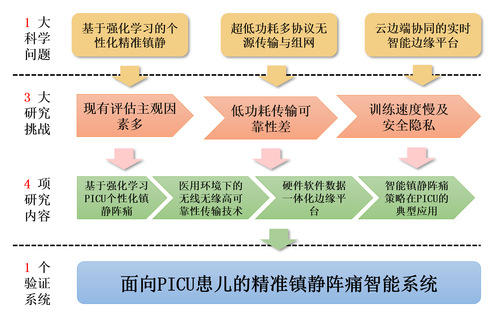Period
2023.1-2026.12
Cooperative unit
The First Affiliated Hospital of USTC
Introduction
PICU is an important place for the treatment of critically ill children. Accurate and effective sedation and analgesia assessment is the core issue for the treatment and improvement of the survival rate of PICU children. Pain in PICU children is the result of the combined effect of many factors, and there are methodological challenges in the measurement of pain and sedation levels. At present, PICU information systems at home and abroad face challenges such as low intelligence, manual assessment of sedation and analgesia, and inaccurate sedation and analgesia strategies, resulting in compromised clinical outcomes and related complications and adverse events. In this project, we plan to investigate the two core problems of continuous monitoring of sedation and analgesia levels and dynamic adjustment of strategy in PICU. First, we will study personalized and accurate sedation recommendations for sequential decision-making, and model the process of accurate sedation and analgesia adaptation based on reinforcement learning, so as to achieve dynamic adjustment of sedation and analgesia strategies in PICU. Secondly, for the problem of continuous status monitoring of PICU children, we plan to introduce ultra-low-power passive sensing technology to achieve reliable passive transmission in the medical environment. At the same time, we will build a PICU edge computing platform with data privacy protection to realize automatic sedation and analgesia assessment with ultra-low latency and improve the intelligence of the PICU information system.
Methodology
The research structure of this project is as follows

The objectives of this project are to investigate the fundamental theory, key technologies, and clinical applications of the PICU precision sedation and analgesia intelligent system.
I. Reinforcement learning-based personalized precise sedation and analgesia adaptation method for PICU
Firstly, personalized treatment protocols are adapted to a Markovian decision process, followed by optimal strategy learning, and then solving the exact and irregularly sampled time series data to make the best choice in terms of each sedative drug and dose, ventilator settings, initiation of a spontaneous breathing trial, or extubation when the randomness of the underlying process, delayed behavioral effects, and uncertainty in state transitions and outcomes are captured.
II. Wireless Passive High-Reliability Transmission Technology in Medical Environment
This project proposes to use the backscatter communication technology, combined with WiFi, Bluetooth, ZigBee, and other mainstream wireless communication protocols on the market today, to achieve wireless passive high-reliability transmission in the medical environment. The high-reliability wireless transmission will be achieved by direct modulation technology, high throughput wireless transmission by guided frequency modulation technology, and efficient wireless transmission by multi-protocol identification technology, respectively.

Ⅲ. Build the PICU edge platform with hardware-software-data integration
The PICU edge platform is an integrated hardware, software, and data platform. This project starts from three levels: hardware, software, and data. At the hardware and software levels, we use FPGA acceleration and design fast startup algorithms to improve the speed of application deployment and usage and increase the efficiency of the PICU Edge Platform. At the data level, we build a data privacy protection method for the well-known DIKW architecture to improve the effectiveness and security of the PICU edge platform, starting from data security and privacy protection.
